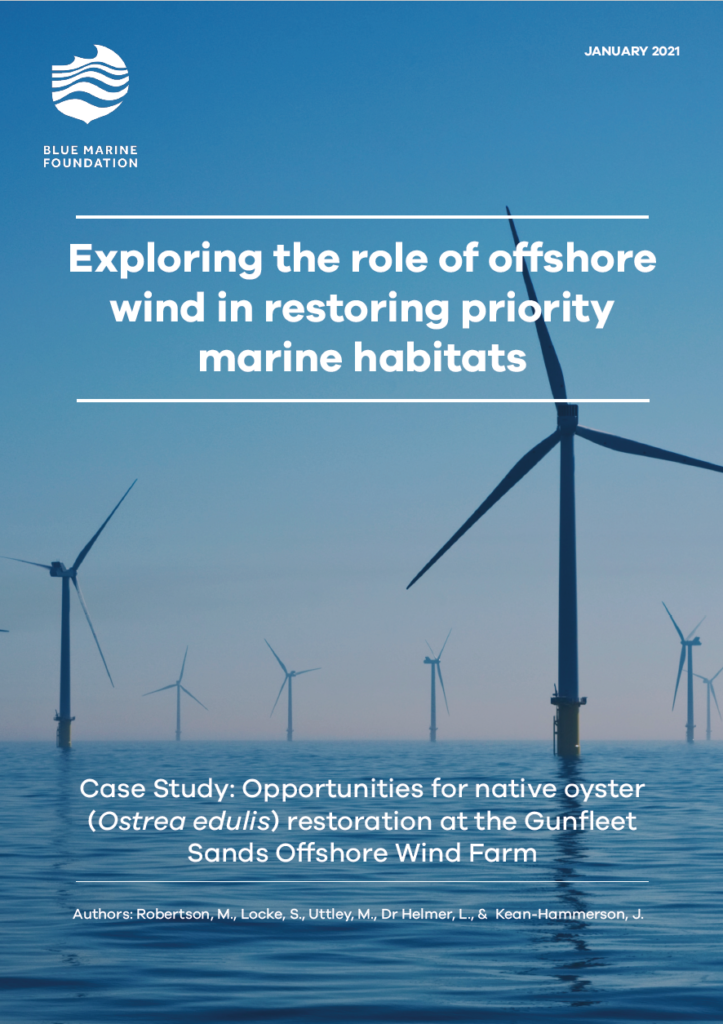BLUE is undertaking a national review of more than 50 wind farms to see how they might benefit marine species, thanks to a ground-breaking study in conjunction with the renewable energy company, Ørsted, that assessed the suitability of an offshore site for restoring native oyster beds.
The potential for rewilding the sea around wind farms is considerable since the UK has the biggest offshore wind generating capacity in the world and the government has committed to quadrupling this target by 2030.
The bases of offshore wind turbines can act as artificial reefs and fish aggregation devices, with global studies showing increased abundance of marine life within wind farms.
In the North Sea, the expansion of the offshore wind farm sector has seen a focus on restoring the native oyster. Native oysters once covered roughly 20 per cent of the North Sea, with populations across Europe having declined by 95 per cent since the mid-1800s. Results from pilots in the Netherlands have shown oysters can grow and reproduce in offshore wind farms.
The study by BLUE and Ørsted, the first of its kind in the UK, tested the optimum conditions within a wind farm needed for oysters to breed and thrive.
Building on the work in the Netherlands and other European countries the study explored the feasibility of using an Ørsted operated offshore wind farm in Essex, Gunfleet Sands, to house adult “broodstock” oysters and contribute to restoration of inshore populations.
Gunfleet Sands wind farm is situated off Clacton-On-Sea and lies in close proximity to the Blackwater, Crouch, Roach and Colne Estuaries Marine Conservation Zone (MCZ). The MCZ is the only designated site for native oyster beds in the UK and the Essex Native Oyster Restoration Initiative has been leading efforts to restore populations to a self-sustaining level since 2011.
The use of broodstock sites to increase larval supply is considered an effective strategy to restore self-sustaining populations. Restoration projects, including BLUE’s Solent Oyster Restoration Project, have successfully used marinas as broodstock sites, pumping billions of larvae into the Solent.
The feasibility study on Gunfleet Sands, carried out by Resilient Coasts, assessed the physical processes at the wind farm and how these would impact oyster survivability. Key considerations included: environmental tolerances for native oyster survival; combined hydrodynamics (waves and tides); operational requirements and the design of oyster housing as a result of the in-depth assessment of these factors, we now understand the optimum conditions within a UK wind farm for oysters to breed and thrive.
As a result of the new understanding gained during the Gunfleet Sands, it was decided not to proceed to a pilot phase at that site but the company and BLUE have already looked at other locations which scored higher according to the criteria they have developed.
BLUE remains confident of finding sites that may be more suitable for native oyster restoration. The review is also looking at other forms of habitat enhancements such as artificial reefs for fish, kelp and mussel beds.
It is hoped that these new findings and the partnership between BLUE and Ørsted will inspire other operators to incorporate nature enhancement into their operations.
BLUE hopes to build a network of project collaborators in academia, conservation, marine engineering and other relevant sectors. If you would like to get involved with BLUE’s offshore wind farm work, please get in touch with Morven Robertson on morven@bluemarinefoundation.com.
Read the feasibility study here:




















